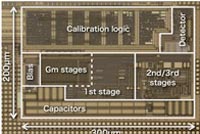Innovative amplifiers for high-spatial-resolution biomedical and environment monitoring system

Designing concept for STB<br>
This report is featured in the March 2013 issue of the Toyohashi Tech eNewsletter : http://www.tut.ac.jp/english/
newsletter/index.html
Small instrumentation amplifier for high density arrayed sensor devices
Small-area, low-power, low-noise instrumentation amplifiers (IA) are critical components of arrayed sensor devices used for high-spatial-resolution biomedical and environment monitoring system.
However, in order to realize small offset voltages of IA, conventional IAs utilize analog filters¡ªcomposed of large passive components, resistors and capacitors¡ª resulting in excessively large silicon chips.
Now, Ippei Akita and colleague at Toyohashi University of Technology have developed a novel architecture for fabricating smaller sized integrated circuit chips. The technique is based on a digital calibration scheme for minimizing the offset voltage of the IA circuit, instead of an analog scheme used in conventional circuits.
The offset exists mainly at the first-stage circuit of IA. In this design, the researchers introduced a reconfigurable first-stage circuit. The best configuration for minimizing the offset was easily determined by calibration logic which was implemented in a small area compared to analog circuits.
The proposed IA was implemented in a standard 0.18 micrometer CMOS and resulted with an offset voltage of
The researchers plan to use the proposed IA for the fabrication of an arrayed IA for high-spatial-resolution and real-time sensing systems.
About Toyohashi University of Technology:
Founded in 1976, Toyohashi University of Technology is a vibrant modern institute with research activities reflecting the modern era of advanced electronics, engineering, and life sciences.
Website: http://www.tut.ac.jp/english/
About the Electronics-Inspired Interdisciplinary Research Institute (EIIRIS):
EIIRIS is Toyohashi Tech¡¯s new flagship research complex launched on 1st October 2010. “The aim of EIIRIS is to produce world-class innovative research,” says President Yoshiyuki Sakaki. “To do this we are bringing together ambitious young researchers from diverse fields to collaborate on pioneering new frontiers in science such as brain/neuro-electronics as well as tackling some of the major issues mankind faces today: issues such as environmental changes and aging societies.”
Website: http://www.eiiris.tut.ac.jp/index.html
Associated links
http://www.tut.ac.jp/english/newsletter/index.html
Journal information
Authors: Ippei Akita and Makoto Ishida
Title of original paper: A 0.06mm2 14nV/¡ÌHz chopper instrumentation amplifier with automatic differential-pair matching.
Journal, volume, pages and year: IEEE Int. Solid-State Circuits Conf. Dig. Tech. Papers (ISSCC), pp.178-179, Feb. 2013
Affiliations: Department of Electrical & Electronic Engineering, Toyohashi University of Technology.
Department website: http://www.int.ee.tut.ac.jp/icg/
Media Contact
All latest news from the category: Power and Electrical Engineering
This topic covers issues related to energy generation, conversion, transportation and consumption and how the industry is addressing the challenge of energy efficiency in general.
innovations-report provides in-depth and informative reports and articles on subjects ranging from wind energy, fuel cell technology, solar energy, geothermal energy, petroleum, gas, nuclear engineering, alternative energy and energy efficiency to fusion, hydrogen and superconductor technologies.
Newest articles

Superradiant atoms could push the boundaries of how precisely time can be measured
Superradiant atoms can help us measure time more precisely than ever. In a new study, researchers from the University of Copenhagen present a new method for measuring the time interval,…

Ion thermoelectric conversion devices for near room temperature
The electrode sheet of the thermoelectric device consists of ionic hydrogel, which is sandwiched between the electrodes to form, and the Prussian blue on the electrode undergoes a redox reaction…

Zap Energy achieves 37-million-degree temperatures in a compact device
New publication reports record electron temperatures for a small-scale, sheared-flow-stabilized Z-pinch fusion device. In the nine decades since humans first produced fusion reactions, only a few fusion technologies have demonstrated…





















